Are we now at the top of the V-shaped recovery?
By now most investors are tiring of their inboxes being filled by sell-side economists and strategists talking about reflation, how much more optimistic they are relative to consensus, and for how much longer the reflation trade will persist.
To be clear, there were very few people talking about a strong V-shaped recovery this time last year. Indeed, a scan of the forecasts of leading sell-side economists in April 2020 shows consensus* forecasts of 3% for the CY21 for Australia and 3.8% for the USA.
Indeed, peak pessimism was not reached until September 2020, when economic growth downgrades ceased and modest upgrades commenced. Currently, the consensus for CY21 has risen to 5.7% in the USA and 4.4% for Australia.
By contrast, our forecasts for the US in 2021 – which we published in mid-April 2020 – was 6.5% (represented by the cross in Chart 1). For
Australia (Chart 2) we were even more optimistic, forecasting 7.0% economic
growth. As we moved through 2020, it was clear the expected contraction in
economic growth in 2020 was going to be less than expected and hence we reduced
our forecast rebound in Australia’s economic growth in 2021 to a still sizeable
6.0%.
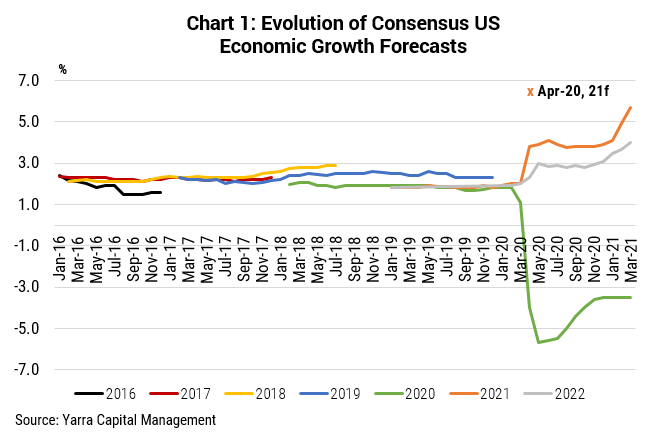
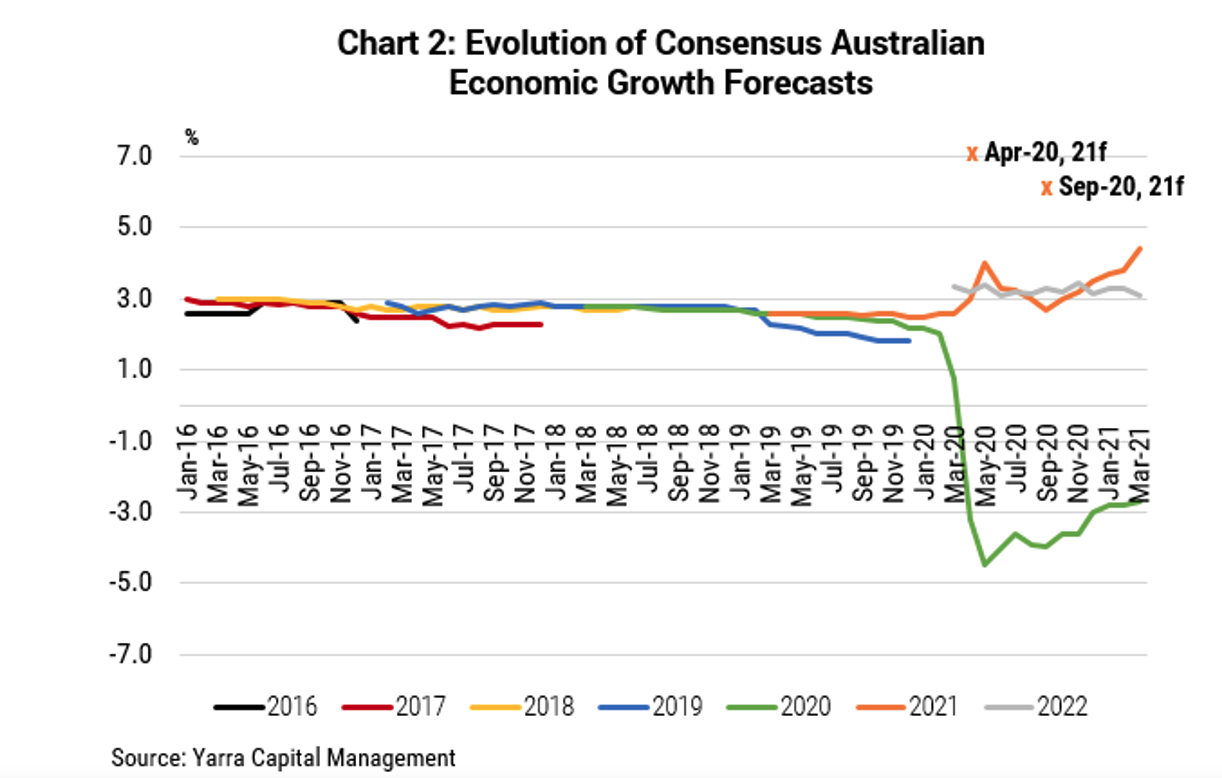
Much of our more upbeat analysis was based on:
- the nature of the shock being more akin to a natural disaster;
- the quantum of the fiscal packages;
- excess credit growth;
- the outlook for vaccine development; and
- the prospect of pent-up demand.
One year on, the clambering to upgrade growth estimates has only intensified. Over the past two months, consensus forecasts for Australian economic growth in 2021 have been upgraded a further 0.7%. In the USA the revision over the past 2 months is a remarkable 1.6%.
In other words, consensus economic growth forecasts are now more realistic, but the upward revisions are not yet complete and there is still scope for consensus to upgrade economic growth further in coming months to nearer our long-held forecasts.
Indeed, when we compare our forecasts for economic growth to consensus there are now examples of economic growth forecasts for the US that exceed our forecast. The most notable is the Bank of Canada’s recent upgrade of 2021 US economic growth from 5.0% to 7.0%. Given the US is Canada’s largest trading partner, the Bank of Canada has a strong incentive to get its US outlook near the mark! The Bank of Canada also lifted its global growth forecast in 2021 to 6.8%, which is 1.25% higher than any global growth year since IMF data commenced (1980) and 0.8% above the IMF’s April forecasts!
However, one of the largest gaps between consensus and our own 2021 forecasts is for Australia. We remain 1.5% above the consensus forecast and around 1% above the most optimistic forecaster. Given there remains an appreciable gap between our forecasts and other forecasters, it’s reasonable to ask what supports our optimism?
1. Australia’s data continues to consistently beat economic forecasters
Charts 3 and 4 show our calculation of economic data surprises for economic activity and inflation relative to consensus forecasts (US vs Australia). A positive reading represents economic data beating consensus expectations weighted by data importance and time decay. Clearly, Australia’s economic activity data is not only continuing to beat increasingly upbeat economic forecasts, the positive data surprises are larger in Australia.
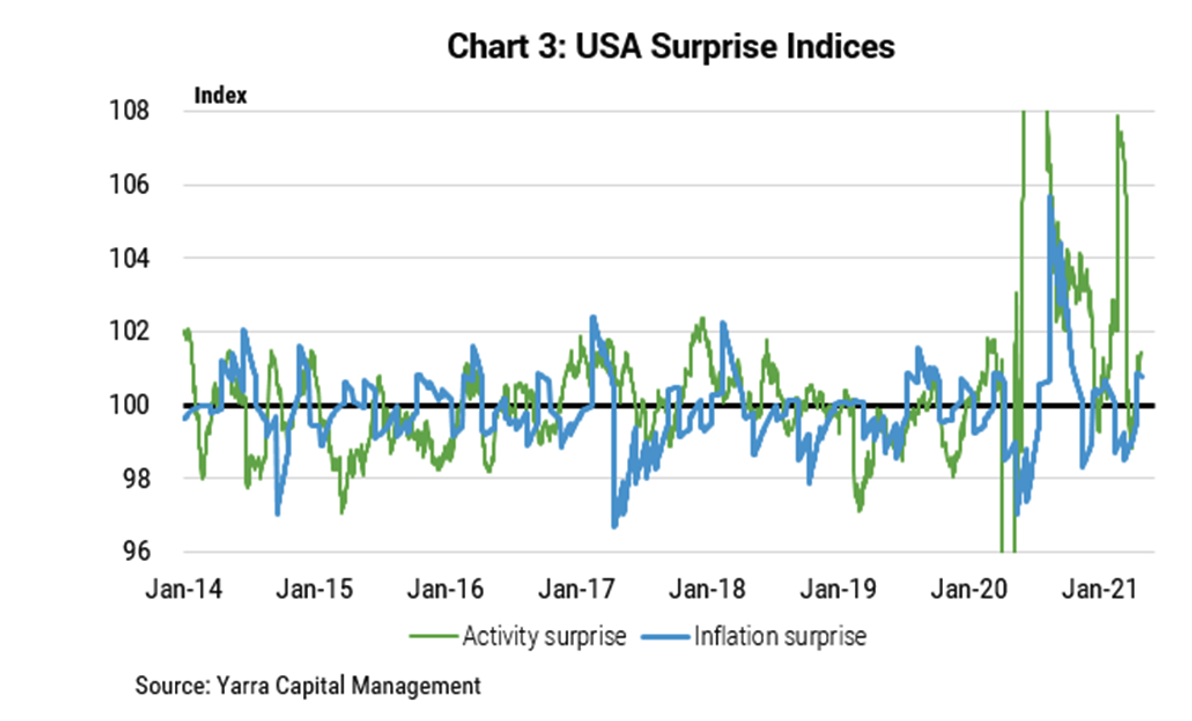
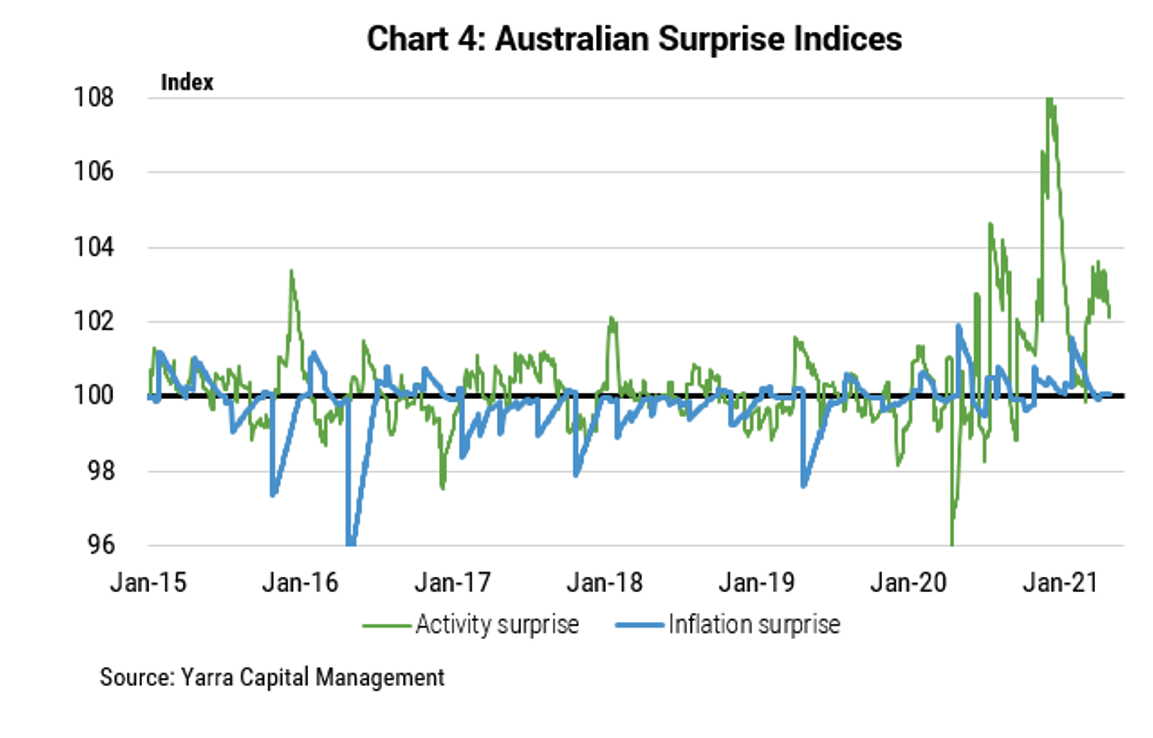
2. Real economic growth is expanding at pace
Secondly, our nowcasting techniques (Chart 5) for
gauging in real-time how fast the economy is expanding already suggest that
real economic growth is expanding at 4%yoy by the end of 1Q2021. That is, we
are about to see a very solid 1Q GDP print for Australia that we expect will be
the catalyst for a further upgrade of the consensus view.
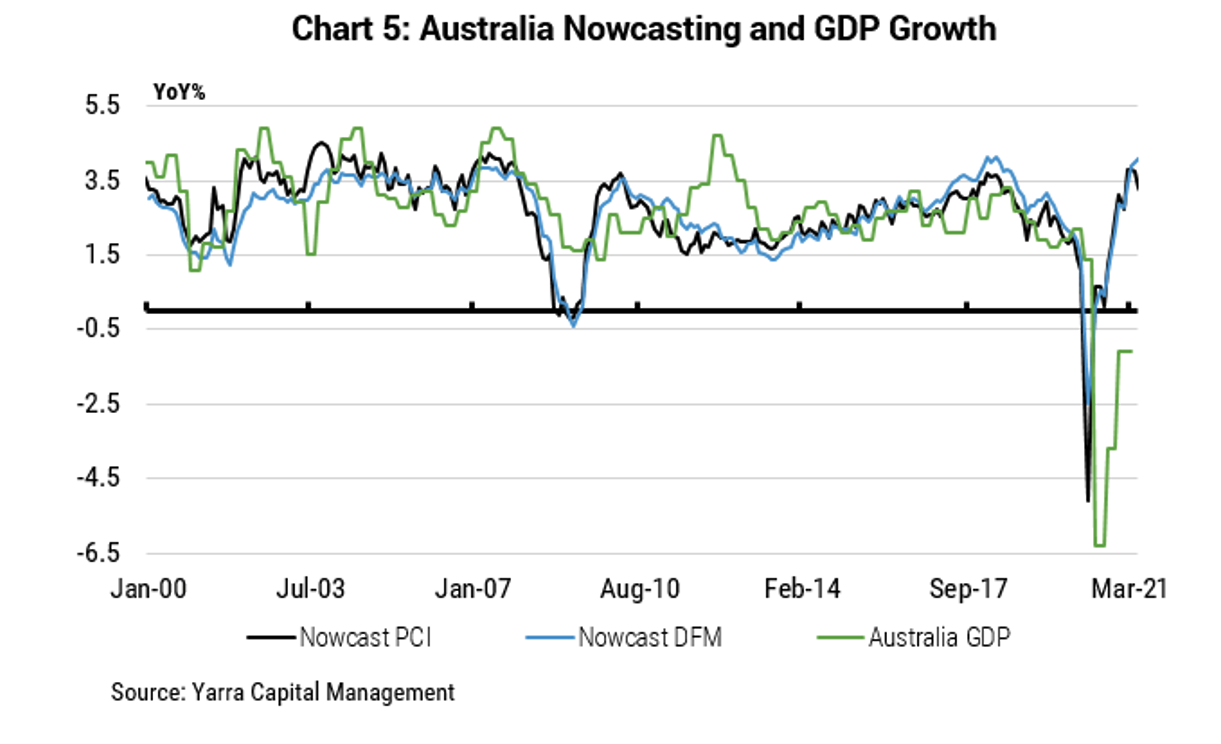
3. Treasury’s projections have been comfortably exceeded
Much stronger economic growth, much lower unemployment and much stronger commodity prices have combined to already deliver a $23bn better fiscal outcome relative to Treasury’s December projections and closer to a $50bn saving over the next 4 years. The question for Q2 is how much more of an “economic surprise” dividend will likely flow through the Budget and what will the Government do with it?
In simple terms, we believe the Treasury’s growth figures are 0.5% too low for 2020-21 and 1.25% too low for 2021-22. The unemployment rate is likely too high by as much as 2%. And an iron ore assumption of $55/t embedded in the Budget is currently 1/3rd of the current iron ore price. Clearly, there are further major revenue upgrades to come.
Our take is that the May Budget will be used mainly to evidence the vastly better Budget and economic outcomes that have been achieved. We expect the true election Budget will come in late 2021 (i.e. mid-year Budget), with more strategic spending and tax changes announced to setup a May 2022 Election.
This strategy allows plenty of time for the Coalition to address its problems in WA, QLD and metro Melbourne, where no doubt most of the Budget windfall will be redirected through 2H21. The combination of the Coalition’s political challenges and the Budget’s economic windfalls will likely spark additional fiscal spending later in 2021, sufficient to bolster economic growth expectations.
Mid-2021 will likely mark the peak of global business sentiment surveys and global economic data surprises. It will also mark the final phase of economic growth upgrades. Nevertheless, we believe there is more oxygen in Australia’s economic recovery and that consensus has long been too slow to recognise the domestic economy’s capacity to expand at close to 6% through 2021. Indeed, we believe there is a high likelihood that the RBA will use the May Statement of Monetary Policy as a platform for a significant upgrade in economic growth forecasts, in a similar vein to the Bank of Canada’s recent upgrade.
While this will set off expectations of a higher
cash rate ahead of the RBA’s 2024 guidance, the RBA can be expected to attempt
to allay those fears by making the case that inflation expectations and wage
growth remains too low to be consistent with their inflation objective.
Nevertheless, the likely RBA growth upgrades will almost certainly end the
prospect of the RBA rolling the 3-year bond beyond the April 2024 target.
Together with the end
of the Term Funding Facility in mid-2021 the reality is that a very modest
tightening cycle is already commencing.
Never miss an insight
Stay up to date with all my latest macroeconomic insights by hitting the follow button below and you'll be notified every time I post a wire.
5 topics

